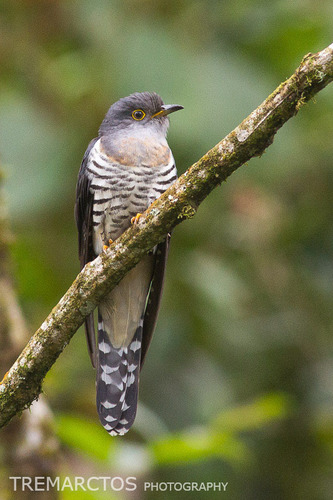
Lesser Cuckoo
The Lesser Cuckoo (*Cuculus poliocephalus*) is a fascinating bird species known for its brood parasitic behavior, similar to the Common Cuckoo. It plays a unique ecological role by laying its eggs in the nests of other bird species, which then raise the young cuckoos. This behavior has significant implications for the host species' populations and evolutionary dynamics. Culturally, cuckoos, in general, are often associated with spring and are subjects of folklore and literature, though specific lore about the Lesser Cuckoo may be less widespread than that of the Common Cuckoo.
25-27 cm
Length
42-48 cm
Wingspan
Least Concern
Conservation Status
Distribution
The Lesser Cuckoo has a broad distribution, breeding across parts of Asia, including India, China, and Japan, and migrating to Southeast Asia and parts of Africa for the non-breeding season. It is also observed in limited numbers in Europen countries. Altitudinally, it can be found from lowlands up to montane forests.
Lifespan
Unknown, but likely several years in the wild, similar to other small cuckoo species.
Lesser Cuckoo's Habitat
Habitat Types
Forests, Woodlands, Scrublands, Cultivated areas with scattered trees
Climate Zones
Temperate, Subtropical, Tropical
Adaptations
Its migratory behavior allows it to exploit seasonally abundant food resources and suitable breeding conditions across different regions. The relatively small size compared to other cuckoos may allow it to utilize a wider range of host species.
Variations
No well-defined subspecies are widely recognized, though some regional variations in plumage and vocalizations may exist.
Appearance
Breeding Plumage
Adults are generally greyish-brown above and barred below. There is no significant seasonal variation in plumage.
Seasonal Feather Changes
None
Sex Based Plumage Differences
Males and females are very similar in appearance.
Notable Features
Slender body shape, Long tail, Barred underparts
Diet and Feeding
Primary Foods
Insects, Caterpillars, Larvae
Foraging Behavior
The Lesser Cuckoo primarily forages in trees and shrubs, gleaning insects from foliage. It may also occasionally take insects on the ground.
Specializations
Like other cuckoos, it can consume hairy caterpillars that are avoided by many other birds.
Seasonal Diet Variations
Diet likely varies depending on insect availability, with a greater reliance on caterpillars during the breeding season when feeding young.
Behavior
Social Structure
Generally solitary, except during brief interactions for mating.
Communication
Distinctive calls, often described as a rapid 'kwee-kwee-kwee' or 'po-po-po', Calls are used for territorial advertisement and mate attraction
Migration
Migratory, moving between breeding and non-breeding grounds in response to seasonal changes in food availability and climate.
Territorial or Group Behaviors
Males are territorial during the breeding season, defending areas with suitable host nests.
Conservation
Threats
Habitat loss and degradation, Pesticide use affecting insect prey, Climate change potentially impacting breeding synchrony with host species
Protection Programs
General habitat conservation measures benefit this species, Monitoring of cuckoo and host populations
Local National Laws
Protected under various national wildlife protection laws in different parts of its range.
Population Trend
Stable
Population Estimates
No precise global population estimate is available, but it is considered relatively common within its range.
Interesting Facts
It is a brood parasite
Like many cuckoos, the Lesser Cuckoo lays its eggs in the nests of other bird species.
The Lesser Cuckoo chick often evicts host eggs or chicks
This ensures the cuckoo chick receives all the food provided by the host parents.
It can eat hairy caterpillars
This adaptation allows it to exploit a food source avoided by many other birds.
Faqs about Lesser Cuckoo
What does a Lesser Cuckoo sound like?
Its call is a rapid, repeated 'kwee-kwee-kwee' or 'po-po-po' sound.
Why does the Lesser Cuckoo lay its eggs in other birds' nests?
This is a reproductive strategy called brood parasitism. It allows the cuckoo to avoid the costs of parental care, but it can have negative impacts on the host species.
Where does the Lesser Cuckoo migrate?
It migrates between breeding grounds in Asia and non-breeding grounds in Southeast Asia and parts of Africa.
Copyright @ Nature Style Limited. All Rights Reserved.
 English
English